Great books often feature between their start and end a symmetry, a circularity that brings a fulfilling sense of completeness and elegance.
The Bhagavad-gita too features between its start and end a sublime symmetry.
The Gita contains two conversations: an outer scene-setting conversation between Dhritarashtra and Sanjay, and a central substance-expounding conversation between Arjuna and Krishna.
The Gita, along with its scene-setting conversation, begins with Dhritarashtra’s question: What did the two armies assembled for fighting on the Kurukshetra battlefield do? (01.01)
His enquiry might seem odd, like asking: what did people assembled for eating in a hotel do? The answer might seem self-evident: they ate. Or, in the Gita’s case, they fought.
His intent in asking this question is revealed in his use of the word “the field of dharma” (dharma-kshetra). He is worried about how the dharmic setting for the war would affect his adharmic sons’ fortunes. Thus, his implicit question is: How were the fortunes of those on the battlefield affected by dharma? That question applies to all of us – in the battlefield of life, how will our fortunes be affected by dharma?
The substance-expounding conversation begins with Arjuna’s question: Being confused, I ask you what is dharma (02.07). Krishna analyzes various kinds and levels of dharma, and concludes that the summit of dharma is the harmonization of the human will with the divine will. (18.66)
And Sanjaya concludes the Gita by declaring that where the human and the divine will are in harmony, there will be victory (18.78). This concluding verse does three things: conveys the Gita’s essential message about dharma; answers through a prophecy its implicit starting question; and inspires us to ascend to the acme of dharma – to harmonize with the divine, thereby attaining victory in our life-battles.
Such is the Gita’s subtle and sweet symmetry.
To know more about this verse, please click on the image
Explanation of article:
Podcast:
Download by “right-click and save”


GITA is the sublimeTRUTH
Hare Krsna Prabhuji.. wonderful article..Essence of Gita in one verse……